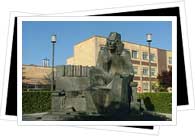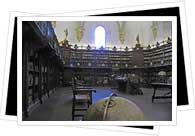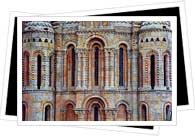Highlights:
The Salamanca University quarter is perhaps the most monument-laden part of town- or at least the part that people are most drawn to! Full of massive structures, centuries of history, great prestige and even a secret or two, get your camera ready and hit the tourism trail. A central spot to start out at is naturally the Salamanca University- the source of Salamanca's academic prestige. Once considered one of the "four lights of the world" along with Paris, Oxford, and Bologna, the Salamanca University's main building was constructed to fit its reputation.

The golden, sandstone façade features perhaps the ultimate expression of Plateresque architecture- lose yourself amongst the carved medallions, heraldic emblems, floral motifs, mythical heroes, religious scenes... the list goes on! Hidden within this sculpted tapestry is one of Salamanca's secrets: the ever-elusive frog. If you are able to find it (without somebody pointing it out to you, that is), you're guaranteed good luck and marriage. Then again, if you don't put good luck and marriage in the same category, maybe you don't want to find it!
Also gracing the university building is a unique type of graffiti- and no, not the kind that brings about legal consequences for being caught. For centuries, when students passed their final exam they would write upon the walls of the university- while most of the writing is now illegible, you can still see traces of the red paint!
Inside the Salamanca University is a wealth of other interesting sights that make the entrance fee definitely worthwhile. On the first floor you'll find the old lecture rooms arranged around a central courtyard. The most interesting of them is perhaps the Aula Fray Luis de León, which boasts the rooms original benches and the pulpit of Salamanca's most famous professor who, after being arrested in the University during the Spanish Inquisition, returned to his pulpit after spending five years imprisoned and began right where he left off, saying "As I was saying yesterday..."
 Upstairs the highlight is without a doubt the Salamanca University library. Boasting thousands of antique books arranged on wooden shelves and huge globes of the world, it will certainly give you an idea of the unrivalled academic splendor of the Salamanca University during the Renaissance.
Upstairs the highlight is without a doubt the Salamanca University library. Boasting thousands of antique books arranged on wooden shelves and huge globes of the world, it will certainly give you an idea of the unrivalled academic splendor of the Salamanca University during the Renaissance.
Just around the corner from the Salamanca University you'll come across the cathedral complex composed of the Catedral Nueva (New Cathedral) and the adjoining Catedral Vieja (Old Cathedral). The newer of the two, was constructed over two centuries. Starting in 1512, already well into the Renaissance, the cathedral boasts varying styles ranging from Gothic (Queen Isabel was a big fan of Gothic architecture) to late Baroque.
For the best example of the evolution of architecture of the 200 years of its construction, seek out the massive dome where you'll see Gothic elements at its base which then eventually works its way up to the late Baroque-style peak. Finally, be sure to pay attention to the decoration surrounding the massive doors on the Catedral Nueva's exterior; every time a scuptor comes to do a restoration or a touch-up, he can add a personal touch as a trace of his work and of his times. For this reason, you'll find an astronaut and an ice cream cone amongst the otherwise Renaissance and Baroque adornment!
 Connected to the Catedral Nueva, which serves as a support, is the Romanesque-style Catedral Vieja. Not only is it a stellar example of Spain's early Christian architecture, but it also boats a massive 53-painting altarpiece from the 15th century and Europe's oldest organ. The organ itself is quite the attraction- housed in the Capilla del Obispo Diego de Anaya (Chapel of Bishop Diego de Anaya), it boasts intricate and impeccable Moorish-inspired elements. However the Catedral Vieja's most distinctive feature is its "media naranja" (half orange) dome, called the Torre de Gallo (cock tower) because of the rooster-shaped weathervane perched upon its cusp.
Connected to the Catedral Nueva, which serves as a support, is the Romanesque-style Catedral Vieja. Not only is it a stellar example of Spain's early Christian architecture, but it also boats a massive 53-painting altarpiece from the 15th century and Europe's oldest organ. The organ itself is quite the attraction- housed in the Capilla del Obispo Diego de Anaya (Chapel of Bishop Diego de Anaya), it boasts intricate and impeccable Moorish-inspired elements. However the Catedral Vieja's most distinctive feature is its "media naranja" (half orange) dome, called the Torre de Gallo (cock tower) because of the rooster-shaped weathervane perched upon its cusp.
Finally, at the most southern part of the Salamanca University is the Puente Romano (Roman bridge). Sprawling the Tormes River, the 400 meter, 2000-year-old bridge proves one fact: Romans definitely knew how to built things to last! Nowadays the bridge offers a stunning view of the old city climbing up the hill.